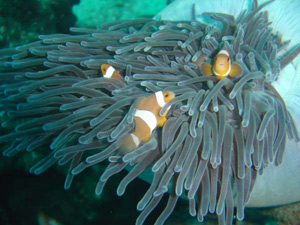The thing I love most about diving is not quite knowing what you’re going to find when you get down there.
You stare off the boat onto the water’s shiny silver-blue surface just imagining the world beneath, busy with a purpose – just like ours. Except it’s not like ours. It’s a kaleidoscope of colours down there, more amazing than any scenery I’ve ever seen up here. The intensity hits you within seconds of your head breaking the surface.
It’s as if someone’s switched on the mute button and turned up the peacefulness. You feel like you’ve just landed in a giant aquarium, yet the fish don’t know you’re there and carry on without hesitance or regard. It’s an experience that makes your heart stop in the first instance, just as the warm water hits your face and the magical surroundings take hold, and then it begins to race as you watch fish flicker past your eyes just millimetres away and you become conscious that you’re breathing underwater. Part of you can’t believe it’s possible, and for a second you resist it, as it shouldn’t be possible. But then you relax and within seconds it seems like the most natural thing in the world and you love it!

For me diving’s just a natural extension of my love for travelling. The ocean is another place to explore, somewhere different to go and something new to see. It’s a place where not everyone’s been before and the experience will never be the same twice. And like travelling, diving’s addictive. No sooner has one dive ended then another one needs to be planned.
Diving fits perfectly into the traveller’s lifestyle – it’s adventurous, it’s different, it’s sociable and above all it oozes sexiness. These are the very reasons why the sport is becoming so popular amongst today’s young backpacker crowd.
Now you wouldn’t usually think of diving as a backpacker pastime – it’s generally associated with pricey kit, expensive courses and exotic destinations – but progressively more people are taking it up and it’s easy to see why. With travellers visiting lots of exotic countries, diving is becoming more and more accessible to them, especially when it’s as affordable as it is in Thailand.
Thailand is one of Southeast Asia’s easiest countries to travel in and conditions here are perfect for diving. The waters surrounding the mainland are made of the stuff that divers dream of and the variety of diving is pleasantly surprising. In fact, as a diving destination, the country seems to have it all – sparkly turquoise water, hot days, colourful marine life, great food and a sleepy laid back lifestyle. But best of all you can go diving in Thailand whenever you want as it’s one of the few countries with good year round diving, so your visit here won’t be controlled by the weather patterns. The only thing that matters is what side of the country you’re on – when it’s high season in the west, it’s low season in the East and vice versa. So in theory, you should always find somewhere decent to dive.
In saying this however, the best diving in Thailand is definitely to be found in the south of the country. To the east of the country in the Gulf of Thailand you have the waters around the islands of Koh Samui, Koh Phangan and Koh Tao and to the west you have the Andaman Sea along with its world-class diving sites – Koh Similan, Hin Daeng and Hin Muang.

Koh Tao, or Turtle Island, dominates the dive scene on the East Coast and is a hot spot on the backpacker trail for gap year travellers wanting to secure their PADI Open Water before hitting Australia and the Gold Coast prices. The dive scene on the island fits in perfectly with what most backpackers want – low costs, sun, fun, sea and sand as well as great Thai food and very cheap drink.
As you’d imagine, there are scores of dive centres to choose from on the island, both big and small. Some of the most established names however include Buddha View, Big Blue and Crystal Dive. Big Blue Diving was one of the first dive shops to open on the Gulf of Thailand and has built itself a great reputation for providing great facilities, equipment, courses and fun diving for all levels. To take your Open Water course with Big Blue costs around 9,000 baht (that’s just £137), and includes four dives plus lectures. A fun dive for you qualified divers, including kit hire, costs a mere 1000 baht (£15) which is incredibly cheap! In fact, all of the dive centres on the island charge similarly low prices, which means there’s little to choose between them. Just make sure, whichever dive school you choose, that the equipment is new, well maintained and has a low student to instructor ratio.
Whilst the dive sites off Koh Tao aren’t amongst the best in the world, as the reefs have seen much better days and aren’t as pristine as they once were, Koh Tao diving is perfect for the anxious newcomer. Conditions are calm with little current and waters are clear and shallow. The occasional underwater rock formation and swim-through on the other hand will keep the old hand entertained.
More importantly, especially for those who don’t have much time on the island, all of Koh Tao’s main dive sites are within an hour’s boat ride away from land so you can easily fit in up to five dives a day – two in the morning, two in the afternoon and one in the evening.
Not forgetting though the best thing about the island – it’s cheap! In fact all of the dive destinations around Thailand are cheap. The country is fantastic value for money and a young diver’s dream. Not only is the diving amongst the cheapest in the world, food and drink is cut-price too. You can get a decent meal, a local beer and a good view of the evening sunset at a beachside restaurant for less than £3. Now that’s a bargain!
Words: Rachel Witham

